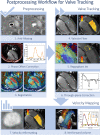4D Flow cardiovascular magnetic resonance consensus statement: 2023 update
- PMID: 37474977
- PMCID: PMC10357639
- DOI: 10.1186/s12968-023-00942-z
4D Flow cardiovascular magnetic resonance consensus statement: 2023 update
Abstract
Hemodynamic assessment is an integral part of the diagnosis and management of cardiovascular disease. Four-dimensional cardiovascular magnetic resonance flow imaging (4D Flow CMR) allows comprehensive and accurate assessment of flow in a single acquisition. This consensus paper is an update from the 2015 '4D Flow CMR Consensus Statement'. We elaborate on 4D Flow CMR sequence options and imaging considerations. The document aims to assist centers starting out with 4D Flow CMR of the heart and great vessels with advice on acquisition parameters, post-processing workflows and integration into clinical practice. Furthermore, we define minimum quality assurance and validation standards for clinical centers. We also address the challenges faced in quality assurance and validation in the research setting. We also include a checklist for recommended publication standards, specifically for 4D Flow CMR. Finally, we discuss the current limitations and the future of 4D Flow CMR. This updated consensus paper will further facilitate widespread adoption of 4D Flow CMR in the clinical workflow across the globe and aid consistently high-quality publication standards.
Keywords: 4D Flow CMR; 4D Flow MRI; Cardiovascular; Clinical; Flow quantification; Flow visualization; Heart disease; Hemodynamics; MR flow imaging; Phase-contrast magnetic resonance imaging; Recommendations.
© 2023. The Author(s).
Conflict of interest statement
No author has and competing interests for this manuscript.
Figures



References
-
- Kamphuis VP, Westenberg JJM, van der Palen RLF, van den Boogaard PJ, van der Geest RJ, de Roos A, et al. Scan-rescan reproducibility of diastolic left ventricular kinetic energy, viscous energy loss and vorticity assessment using 4D flow MRI: analysis in healthy subjects. Int J Cardiovasc Imaging. 2018 doi: 10.1007/s10554-017-1291-z. - DOI - PubMed
Publication types
MeSH terms
Grants and funding
LinkOut - more resources
Full Text Sources

